The following were put together by the various grade school and high school teachers participating in the graduate education course at Johnson’s Island. Groups of three or four students had the assignment to prepare one topic to include on this web site. Here are their contributions. Screening By: Niki Schiefer, Miranda Hessick and Kendra Foos […]
Read full post »Field Reports for 2010
2010 Field Report 6 – Mapping
Thursday, July 8, 2010
Our group, that being group D, and all the others have been mapping all features and artifacts located in-situ in our units and the latrine. The purpose of mapping both features and artifacts is to record the provenience and context within that unit. Mapping requires the following tools: a tripod, total station, plumb bob, level, […]
Read full post »Bone from the Latrine
Saturday, July 3, 2010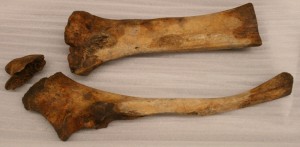
We are finding many animal bones in the sink (latrine) from Block 8 being excavated this year. Two of these bones are from a cow, the radius and ulna. In the pictures below, you can see one end (the proximal end of the ulna) shows a growth cap having yet to seal and the other […]
Read full post »2010 Field Report 5 – Lab Work
Saturday, July 3, 2010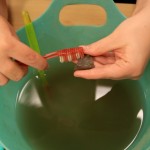
by Zoe van Buren, Jana Irving, Leslie Salyers, Field School Students            An essential component of any archaeological excavation is the processing of the artifacts. Once a week, our class meets in the archaeological lab at Heidelberg University to sort, clean, and label the materials we have excavated from our units. We begin with a […]
Read full post »12-Sided Bottle Discovered
Thursday, June 24, 2010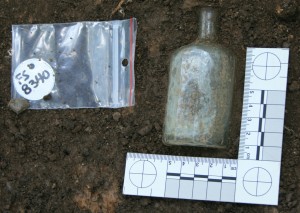
One of the first artifacts to be located within level 1 of Feature 124 (a latrine used in late 1862 or early 1863) was this 12-sided bottle. The bottle is just over 10 centimeters in length and 5 centimeters in width. We have yet to remove the bottle from the latrine, but expect to in […]
Read full post »2010 Field Report 4
Thursday, June 24, 2010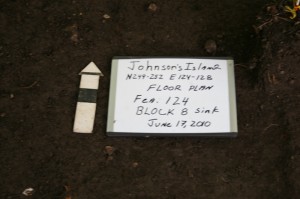
From the 2010 Archaeological Field School Participants: The Block 8 Latrine is a perfect example of how a new archaeological site is begun. After the latrine was located through soil samples, the site was staked out within an existing grid system and we continued to investigate. Members of the excavation teams worked to clear away […]
Read full post »Interesting Lead Artifact
Thursday, June 17, 2010
 This artifact was discovered within the excavations of the Block 8 area. It appears to be lead, having been flattened out and small cut-outs removed. I can’t explain the very small holes, but the other cut-out shapes may have been lead pieces being used for sets in jewelry. It is quite a unique piece […]
Read full post »2010 Field Report 3
Thursday, June 17, 2010
From the 2010 Archaeological Field School: Having arrived and settled in, the Johnson’s Island archaeological field school began on  Monday, June 7th.  We met at the Gilmor Science Building archaeological laboratory where we had a short lecture introducing us to the history and context of the site.  Johnson’s Island was used as the location for […]
Read full post »2010 Field Report 2
Friday, May 21, 2010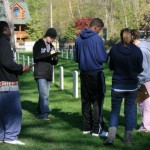
by David Bush, Ph.D. It is my privilege to share one school’s experience at the Johnson’s Island Civil War Prison. The Lorain County Early College High School brought four classes to the Johnson’s Island Civil War Prison site in April, 2010 through Heidelberg University’s Experiential Learning Program in Historic Archaeology. Their teacher, Mark Jaworski (Lorain […]
Read full post »2010 Field Report 1
Monday, May 17, 2010
Investigations at the Johnson’s Island Civil War Prison Site by Dr. David Bush This year, our investigations are centered on Block 8 within the Prison Compound. Block 8 was one of the 11 housing blocks used solely for holding the Confederate officers incarcerated at Johnson’s Island. In addition to the 11 general housing blocks, Block […]
Read full post »

